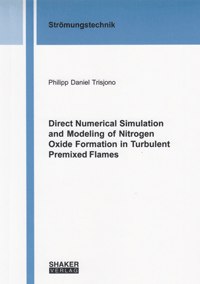
Shop : Rezensionsexemplar
Shop
Rezensionsexemplar

Februar 2017
Philipp Daniel Trisjono
Direct Numerical Simulation and Modeling of Nitrogen Oxide Formation in Turbulent Premixed Flames
Gas turbines are a crucial contributor to the world’s power capacity and will play an increasingly important role in the energy landscape of the future, partly because of their good load flexibility. Diminishing resources and environmental challenges, such as global climate change create a demand for cleaner and more efficient use of energy. Currently, the use of computational fluid dynamics (CFD) is gaining importance for the design of industrial gas turbines in order to exploit the full potential of ultra-low emission combustion systems. An essential prerequisite for high fidelity CFD are predictive combustion and emission models. In this context, direct numerical simulation (DNS) of turbulent combustion is a research area becoming more important, because DNS can enable very systematic analyses and model development. This thesis takes advantage of DNS and develops models targeted for the prediction of turbulent flames and nitrogen oxide formation in gas turbines. These models are developed based on DNS data, which are generated in the context of massively parallel supercomputing employing the fastest presently available supercomputers.
In the first part of this thesis, an accurate and consistent high-order finite difference scheme suited for DNS of turbulent reacting flows is derived. Specifically, an inconsistency in the scheme of Desjardins et al. is identified. As a solution to this issue, a finite difference operator for the mass conservation is reformulated into a consistent flux-based form. The effectiveness of the proposed formulation is shown in two canonical laminar flow configurations, while its applicability is demonstrated in a large-eddy simulation (LES) of a turbulent stratified premixed flame.
Next, a DNS database for a hydrogen-air flame is assessed in order to analyze and model turbulence–chemistry interactions in premixed flames. Since flame stretch effects due to strain are found to be of leading order importance, these are then modeled by a recently proposed strained flamelet model. The strained flamelet model is validated a priori against the DNS and shown to yield improved flame speed and source term predictions.
Following this, nitrogen oxide (NO) formation is investigated and modeled in a turbulent premixed temporally evolving methane-air DNS jet flame, which is described by a detailed chemical mechanism for the NO kinetics in addition to the methane oxidation. An interesting finding is that NO formation under highly turbulent conditions is strongly altered compared to laminar unstretched conditions. Specifically, the formation via the NNH pathway is found to be important for flame generated NO and significantly affected by turbulence, which is shown to be a consequence of differential diffusion. Finally, existing models from the literature are analyzed and a priori evaluated against the DNS. Based on the physical analysis and findings of the optimal estimator analysis, a new model formulation is proposed considering the turbulence–NO chemistry interactions and the modification of NO formation via the NNH pathway.
In the first part of this thesis, an accurate and consistent high-order finite difference scheme suited for DNS of turbulent reacting flows is derived. Specifically, an inconsistency in the scheme of Desjardins et al. is identified. As a solution to this issue, a finite difference operator for the mass conservation is reformulated into a consistent flux-based form. The effectiveness of the proposed formulation is shown in two canonical laminar flow configurations, while its applicability is demonstrated in a large-eddy simulation (LES) of a turbulent stratified premixed flame.
Next, a DNS database for a hydrogen-air flame is assessed in order to analyze and model turbulence–chemistry interactions in premixed flames. Since flame stretch effects due to strain are found to be of leading order importance, these are then modeled by a recently proposed strained flamelet model. The strained flamelet model is validated a priori against the DNS and shown to yield improved flame speed and source term predictions.
Following this, nitrogen oxide (NO) formation is investigated and modeled in a turbulent premixed temporally evolving methane-air DNS jet flame, which is described by a detailed chemical mechanism for the NO kinetics in addition to the methane oxidation. An interesting finding is that NO formation under highly turbulent conditions is strongly altered compared to laminar unstretched conditions. Specifically, the formation via the NNH pathway is found to be important for flame generated NO and significantly affected by turbulence, which is shown to be a consequence of differential diffusion. Finally, existing models from the literature are analyzed and a priori evaluated against the DNS. Based on the physical analysis and findings of the optimal estimator analysis, a new model formulation is proposed considering the turbulence–NO chemistry interactions and the modification of NO formation via the NNH pathway.
Schlagwörter: Turbulent Combustion; DNS; Modeling
Shaker Verlag GmbHAm Langen Graben 15a52353 Düren
Mo. - Do. 8:00 Uhr bis 16:00 UhrFr. 8:00 Uhr bis 15:00 Uhr
Kontaktieren Sie uns. Wir helfen Ihnen gerne weiter.

